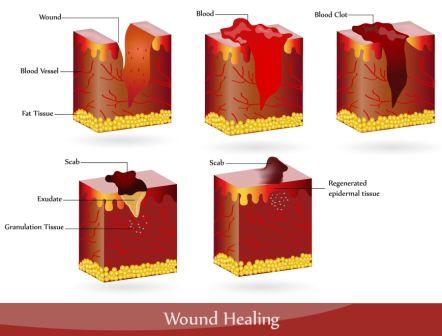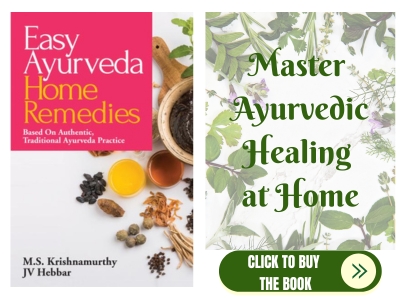Injury, Wound care Ayurvedic Remedies, Medicines
The concept of wound care and wound cicatrization is very well explained in Ayurvedic textbooks. Sushruta, being the father of surgery has explained in detail about wound healing.
Due to external injury, there will be vitiation of three doshas –
Vata imbalance – leading to pain, swelling,
Pitta imbalance – leading to Burning sensation, infection (dooshana) of blood and ulcer wound
Kapha imbalance – accumulation and vitiation of fluids.
Table of Contents
Ayurvedic medicines
Ayurvedic medicines for quick wound healing:
Murivenna oil: can be used for pichu (cotton swab immersed in the oil is applied over the affected part. Very effective in wounds with severe pain. (Reference: Yogagrantham)
Aragwadhdai Kashayam Tablet: To cleanse wounds, can be used for local Dhara. (Reference: Ashtanga Hrudayam)
Guggulutiktakam Kashayam Tablet: Relieves inflammation & infection when administered internally. (Reference: Ashtanga Hrudayam)
Mahatiktakam Kashayam Tablet: Purifies blood and accelerates the healing process. (Reference: Ashtanga Hrudayam)
Tiktakam Kashayam Tablet: Action pretty much similar to above.
DOSAGE OF ALL KASHAYAM TABLETS – two tablets two times a day, before food, with a glass of water.
(Reference: Ashtanga Hrudayam)|
In case of intense swelling: Punarnasavam, Gokshuradi Guggulu, Gokshuradi Guggulu DS
In case of fever: Amrutottara Kashayam tablet, Amrutarishta.
In case of severe pain: Maharsanadi Kashayam tablet.
Ayurvedic wound healing remedies:
Phalatrikadi kwath with Sarapunkha churna
Gandhaka Rasayana
Neem oil – external application
Medicinal formulations for Vrana From Sahasra Yoga Text Book
Dinesavallyadi Taila
Durvadi Taila
Vranaropana Taila
Vranabhairava Taila
Kaisora Guggulu
Amruta Guggulu
Yogaraja Guggulu
Vrana Lepa
Niruryadi Gutika
Veppin Toladi Kashaya
Pullanyadi Tailam
Gopyadi Ghritam
Unwholesome foods
Food to avoid in case non-healing wounds include –
Curd, black gram, Rajma, Ice cream etc. moistening foods.
Home remedies
The below remedy is useful when there is slough collection, pain and itching.
Ingredients:
- Neem powder / neem leaves – 10 grams
- Vacha (Acorus root) – 10 grams
- Heeng – Asa foetida – 10 grams
- Ghee – 10 grams / 10 ml
- Mustard – 10 grams
- Salt – 10 grams
Take the above ingredients and grind it together well, make a wick. With the help of ghee and asafoetida, it can be easily rolled into a form of wick.
Burn this wick and expose the wound region to its fumes for 5 minutes, 2 times a day.
What can you expect?
Helps in quick wound healing, by keeping infection at bay, relieves itching and pain.
Types of external wounds
- Ghrishta – which exudes fluid mixed with little quantity of blood, associated with burning sensation.
- Avagadha – more severe than Ghrishta
- Vicchinna – more severe than Avagadha
- Pravilambi – deep wound causing injury till the bone
- Patita – Organ gets separated from the body
- Viddha – piercing type of wound
- Bhinna – Piercing wound of abdomen
- Vidalita – wound occurring due to hitting or punch or crushing

Wound Care Treatment
For Ghrishta and Vidalita:
If associated with severe pain, wash with warm Yashtimadhu Ghrita or with Bala taila.
In order to mitigate the heat of wound, drugs which possess astringent taste, cold potency and unctuous properties should be made use for lepa (bandage or local application)
In traumatic wounds which are wide, in order to promote healing, honey and ghee should be specially used.
When accompanied with severe swelling,
Vamana therapy – for wounds of upper body parts.
Virechana therapy – for wounds of lower body parts.
In other types of wounds, due to excessive loss of blood, Vata will be vitiated leading to severe pain. Therefore Parisheka (Sprinkling of medicated kashayam/oil), Swedana (local sudation), lepa (local application of medicine in paste form) and Upanaha (poulties) should be applied.
Snehabasti (a type of Panchakarma) should be done with medicines mitigating Vata Dosha.
Acharya Sushruta has explained 64 types of treatment for wounds.
Among them, the following are a few important ones –
Apatarpana – a type of fasting, or avoidance of food articles that take a long time for digestion.
Alepa – application of paste. It clears the dust and toxins, decreases swelling, brings back normal texture of skin.
Parisheka – Fomentation/sprinkling
Abhyanga – Gentle massage
Swedana – should be done in wounds with severe pain
Panchakarma therapies, based on the Dosha imbalance.
Lekhana – in cases where cut ends of muscle are lying exposed. Here scraping is done with KCl (Saindhava), cotton, Samudra Phena etc.
Eshana – Probing. In case of sinuses with excessive pus collection.
Aharana – Extraction. In case of impacted foreign matter.
Vidravana – Draining out. In case of pus collection.
Seevana – suturing in case the wound is free of any foreign object and in fresh wounds.
Peedana – squeezing to let out pus.
Shodhana – Purification of wounds by using decoction made of – Shankini, Ankota, Karaveera, Suvarchala and Aragwadha.
Avachoornana – sprinkling of powders – in case of wounds with bad smell.
Dhoopana – fumigation by burning Yava (Hordeum vulgare), ghee, Shreeveshtaka, Sarjarasa etc.
Krishnakarma – To bring back black colour of skin in case the skin has turned white after wound healing – For this purpose, Bhallataka is kept immersed in Cow’s urine for seven days, then it is kept immersed in cow’s milk. Later it is dried, cut into pieces and the oil is extracted. The oil is mixed with Khura bhasma (Ash obtained after burning the hard part of the foot of the cow, collected after cow’s death). The paste is applied over the affected area.
Pandukarma – To bring back the white colour of skin, if it has turned black due to a wound. Rohini fruit (variant of Terminalia chebula) is kept immersed for seven days in goat’s milk and then a paste is prepared and applied over the affected part.
Like this many techniques are explained in detail to bring back normal skin texture and colour.
Bruises and Doshas
When a person bruises very easily, is it due to Pitta aggravating factors only?
Dr JV Hebbar:
शोणितक्षये त्वक्पारुष्यमम्लशीतप्रार्थना सिराशैथिल्यं च
śoṇitakṣaye tvakpāruṣyamamlaśītaprārthanā sirāśaithilyaṃ Sushruta Samhita, Sutrasthana 15th chapter
Easy bruising implies weak and brittle blood vessels, veins. This indicates depleted quality of blood tissue and also of blood channels (Rakta kshaya). Brittleness and weakness is also a sign of Vata dosha increase.
Injury to the blood vessels = Brittle Sira, Dhamani – Vata Dosha affecting Rakta.
Treatment and remedies:
Virechana, Ghrita, Stambhana medicines – Triphala – Amla, Haritaki, Vibhitaki,
Manjishta – Rubia cordifolia
Tikta Ghrita
Patola katurohinyadi kashayam
Abhyanga with eladi taila, ksheerabala taila, Bala aswagandhadi taila are also useful to strengthen muscles, veins, arteries and skin.
Read related: Petechial haemorrhage- Ayurvedic management and home remedies










5 comments
passerby
Jaatyaadi Taila is the nost commonly used medicine for wounds and it it not even mentioned.
Aakanksha Sharma
Hello doctor, I have done helix piercing 4 month ago, since then I was taking antibiotic. It got subsided but piercing wound and cartilage swelling did not subsided so I switched to Jatyadi oil and Neem ghanvati and Chandra Prabha vati of patanjali. all was doing well but 2 days back one of ear (cartilage and piercing) got swollen to very much extent (due to pressed while sleeping). Now I am feeling pain even in internal ear and swelling is like it will burst, 1 piercing also got bump which is also not curing even after applying B Tact muprocine cream (feeling heat sensation also in swelling). I am again taking ciprofloxcin antibiotic.Please help.
Suresh
Sir
I had a cut on my finger on left hand in train. It has been 20 days still not recovered. Could not stich as I was in train. The wound has turned black on one side. What do you suggest.
Shukla Shruti
Hello Doctor,
I have some queries related to my father’s health. He is diabetic since 15 years. Now his legs become quite sensitive. Foot nail fungal infection happened 6 months back. He is saying that antibiotic doesn’t suit him, and his digestion affects because of those medicines. He was having itching in leg (below knee), so after that there is a wound formed, and swelling is also there. Could you please advice something on this. Thanks and Regards
Roshni Jain
Hello Doctor
My brothers daughter is 14month old and today she got injured just above her right eye with a cut; and bleeding got stopped after 15minutes approx. Now there is swelling on right side of her face and the cut is also creating irritation what we should do for an early recovery. Since she is so small and can’t sit at a place….?